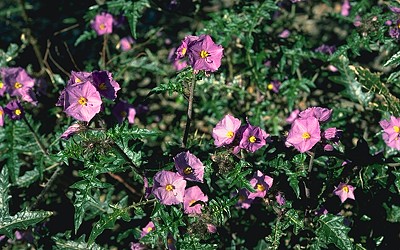
Synonymy
Solanum cinereum R. Br., Prodr. 446 (1810)
T: Banks of the Grose R., N.S.W., 1804 [Oct/Nov 1803], R. Brown s.n.; holo: BM.
Description
Erect or bushy clonal shrub to 1 m, dark green, pubescent with stellate hairs; hairs dense on lower leaf-surface, sparse and mostly along veins of upper surface; minute glandular hairs also present; prickles to 15 mm long, usually abundant on most parts.
Leaves ovate-elliptic, the lamina mostly 6-10 cm long, 3-6 cm wide, discolorous, deeply lobed; petiole 5-15 mm long.
Inflorescence up to 7-flowered, the upper flowers sometimes male; peduncle mostly 2-10 mm long; rachis to 6 cm long, pedicels 5-8 mm long. Calyx 5-10 mm long; lobes usually linear, 3-5 mm long. Corolla campanulate-rotate, 15-20 mm long, mauve-purple. Anthers 3-4 mm long.
Berry globular, usually 15-20 mm diam., dark brown. Seeds 3-4 mm long, usually dark brown. n=12, 24.
Distribution and ecology
Bean (2001) claimed a narrower circumscription for this species than that of Symon (1981) but the two distribution maps look remarkedly similar. It is widespread along the western slopes and tablelands of the Great Dividing Range, extending from Stanthorpe in south-eastern Qld to Albury on the NSW/Vic border. Populations in Victoria and South Australia (Flinders Ranges) represent naturalisations.
Associated with eucalypt woodland on hills and rocky slopes, particularly in disturbed or fired areas.
Common name
Narrawa Burr
Relationships
An andromonoecious species i.e. one in which there are male flowers and bisexual flowers on the one plant. Often there are many male flowers in an inflorescence with 1(-2) bisexual flowers at their base.
Symon (1981) placed S. cinereum in section Melongena, which contained a mixture of andromonoecious and functionally dioecious Australian species, but noted that it did not appear to have any close relationships. The DNA studies of Martine et al. (2006, 2009) indicate that while S. cinereum is not closely aligned with most of the andromonoecious species it does form a group with two other difficult to place andromonoecious species from the Eastern states, S. campanulatum and S. stupefactum .
A group at the RBG Sydney investigating the horticultural potential of the S. brownii group, included S. cinereum in this group, possibly because Bean (2004) treated S. cinereum, along with the S. brownii complex species, as a member of the S. macoorai group of subgen. Leptostemonum. However molecular studies did not support this suggested relationship. A report on their findings can be seen in Marchant et al. (2008).
Reference: Marchant, A. Perkins, P. Orel, G & Towler, G. (2008). Exploring the horticultural potential of native Australian flowering shrubs in the Solanum brownii group. Final report to the Australian Flora Foundation; Martine, C.T., D. Vanderpool, G.J. Anderson, and D.H. Les (2006). Phylogenetic relationships of andromonoecious and dioecious Australian species of Solanum subgenus Leptostemonum section Melongena: Inferences from ITS sequence data. Systematic Botany 31: 410-420; Martine, C.T., G.J. Anderson & D.H. Les (2009). Gender-bending aubergines; molecular phylogenetics of cryptically dioecious Solanum in Australia. Australian Systematic Botany 22: 107-120.
Notes
The highly variable eastern coast species identified as S. brownii, S. cinereum and S. elegans in Symon 1981 were revised in 2001 by Bean (Telopea 9: 639-661).
According to Bean, this resulted in a much narrower circumscription for S. brownii and S. cinereum, the reinstatement of S. amblymerum Dunal (treated by Symon as a synonym of S. elegans) and S. curvicuspe Domin and the reduction of S. elegans to a synonym of S. brownii . An additional six new species were described to encompass the variation encountered - S. armourense, S. celatum, S. limitare, S. neoanglicum, S. nobile and S. silvestre .
While some of the characters may be scored slightly differently in comparing Symon's and Bean's treatments, the distribution of S. cinereum remains more or less the same in both treatments.
European research on eggplant (S. melongena) has included crosses with this species which produced viable hybrids.
Berries of S. cinereum are reported as poisonous to sheep and there are also reports of it being poisonous to goats - see Bourke CA. Cerebella degeneration in goats grazing Solanum cinereum (Narrawa burr). Aust Vet J, 1997; 75:363-365.
Selected specimens
S.A.: 45 km SE of Port Augusta, 1 Oct. 1960, I. Shillabeer (AD); near Crystal Brook, D.E. Symon 5480 (AD, CANB). Qld: 24 km ENE of Killarney, S.L. Everist 8124 (BRI). N.S.W.: Yearinan, 2 Nov. 1954, L.A.S. Johnson & E.F. Constable (NSW).
Plant status, if any
S. cinereum is listed on the Advisory List of Rare or Threatened Plants in Victoria - 2005 as Poorly Known for
From the web
For images of S. cinereum in NSW see the PlantNet site.
Information about S. cinereum and buzz pollination is at http://home.bluepin.net.au/yallaroo/Solanum_cinereum.htm
See the North West Weeds site documenting weeds of the Gwydir and Inverell shires in NSW for an image showing the foliage and flowers of this species.
Further information and links for this species can be found on the Solanaceae Source site.





